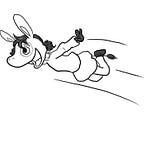Storytelling: When to revise, start over, or abort.
There is perhaps nothing more human than storytelling, for storytelling is using the imagination to communicate ideas that teach our own about the world. Be it drawing & painting, music, dance, or writing/speech, most of us find that all these art forms are best when they tell a story: A good art piece, song, dance, work should have a solid foundation that becomes more engaging as its audience engages, and then ends in a way which moves us.
Right now, I shall focus on the art of storytelling in comics.
What makes a good comic?
Simply put, all good comics will:
- Be easy to follow.
If there is dialogue, reading order should be clear. Readers should always know what’s going on, including when they are missing information. For example, we may not know the secret a character is keeping, but we do know the character is keeping a secret because clues have been provided.
Minimize text in a comic to produce clarity. Most of the story should be visually communicated. - Have characters readers will be invested in.
Characters should not be wish fulfillments and have sympathetic qualities. In general, they should also not be stereotypes but there are exceptions depending on the nature of the plot-line. Good main characters will also grow over the course of the story.
Foster good characters by thinking about their relevance to the plot and providing a backstory which affects their behavior in the comic. - Have a clear message.
A story with no purpose is aimless and unmemorable. You should have a takeaway for your reader. Stories entertain, but good stories leave an impression. You could impress by being ridiculous, but such antics merely evoke readers, not move them.
Ask yourself why you wanted to write this comic. - Build up, and conclude in a way that makes sense.
Any great art will convey a rising action. For comics, this means inspiring your readers to turn the page because they want to know what’s next. When the story must come to an end, it should leave readers feeling like their time and effort was worth the feelings they have when the experience is over.
Make sure every detail you include is relevant: for the readers to experience, for the readers to know, for the readers to takeaway, etc.
There’s a lot of other factors to consider like one’s intended audience and purpose for creating the story. This is why I do not include technical art skills as a requirement.
Revising
Ideally, any lackluster elements of a comic will be caught and fixed before publication. It’s really important to make drafts, and I mean, NEVER settle for the first idea that pops into your head. Write down all ideas as soon as you have them, don’t worry about whether it’s a good or bad one at the moment. Make time to think; imagine scenes while you’re pooping or instead of streaming when you’re bored. There’s no need to plan things out sequentially either, in fact, I found it was most exciting for me to come up with moments I want to happen, and figure out how to connect these events later. Don’t decide it’s the “right” one until you take some time to see if you come up with anything better.
Because it’s a greater investment to draw than to write, I suggest you finalize the events you want in your story before deciding how to draw them. Once you figure out what you want to happen, you still have to decide how to visualize it for readers. Again, make many thumbnails for how you could convey a scene. Have a mood an emotion you want the readers to experience in mind. Take a break before selecting the best set-up so you can experience the visual experience with fresh eyes.
Starting Over
Even after you’ve produced a final version, if you come up with an even better idea, don’t be afraid to completely scrap it because “all that work will have been for nothing”. Creativity flows better when we sit on an idea for a while, so the reality is that without those first couple of drafts, you may never reach the most suitable version for the comic. Yes, it’s difficult to give up sweat and labor (especially if you put in a lot of time to draw a scene), but remember that it’s much more satisfying to have a work you are completely pleased with for a little more frustration and effort.
Aborting
Maybe you’re just stuck: The plot you’ve developed is unsatisfactory. You’re no longer motivated to work on your story because you couldn’t care less about your own characters. You realize the ideas you thought were good don’t work for any number of reasons. Maybe it’s best to come up with an entirely different story. You don’t have to delete all of your work either; maybe you’ll finally figure out how to fix it decades later or something, or maybe the story will never see the light of day again, and that’s okay too.
In General,
Push through stagnation and writer’s block, it’s really tempting to do something else when ideas aren’t flowing, but you’ll find if you just keep at it inspiration will start coming and more easily too. You can also ask others for ideas. I also recommend you bounce ideas off others to see how they feel about them. Your story will always make more sense to you than anyone else, and by sharing your thoughts, you can gauge how well you are conveying the story to others. Still, don’t feel pressure to accomplish x amount by a certain date (assuming making comics isn’t your job). When you are consumed by a need to get your comic over with, you lose sight of its purpose: to move others with your story.
